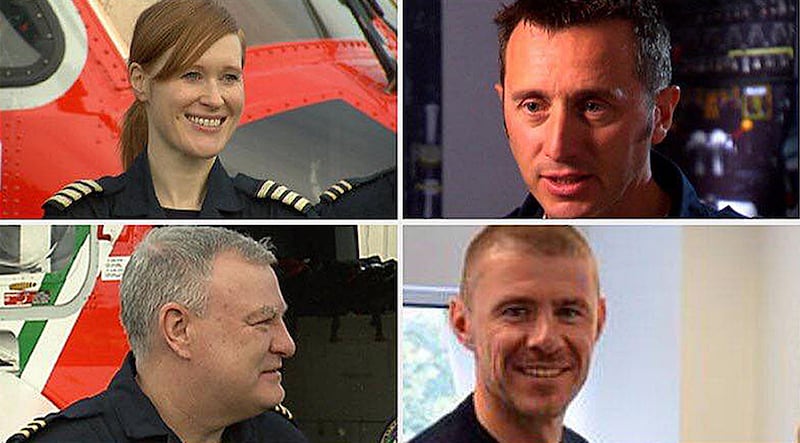An inquest jury has found that the crew of Coast Guard rescue helicopter R116 - Captain Dara Fitzpatrick, co-pilot Capt Mark Duffy, winch operator Paul Ormsby and winch man Ciarán Smith - died by accident when it crashed in March 2017.
Capt Fitzpatrick died by drowning; Capt Duffy died from multiple injuries; while Mr Ormsby and Mr Smith died by drowning and were lost at sea. In each case, the cause of death was the helicopter crash.
The jury reached their verdicts in Belmullet, Co Mayo, after the inquest - which opened but then adjourned in April 2018 - had heard from 23 witnesses, two of them by video link.
A further nine witnesses had given evidence in April 2018 after which the inquest was adjourned to allow for Garda and air accident investigations to be completed.
The foreman, Mark Ruddy, said the jury endorsed all 42 recommendations of the already published Air Accident Investigations Unit (AAIU) report into the crash.
Furthermore, he said, there should in future “be definitive medical criteria as to the dispatching a helicopter, with no ambiguity” and if top cover was needed for an operation, “it should not involve Search and Rescue Service (SARS) aircraft”. He said deficiencies in mapping “contributed considerably to this accident”.

The AAIU report published last November concluded the Rescue 116 crew, flying at night in poor weather, was “unaware” it was heading for the 86m (282ft) Blackrock island - having been tasked to provide “top cover” for another helicopter which was airlifting a casualty from a fishing boat 225 kilometres off the west coast. Ordnance survey imagery “did not show Black Rock, but instead showed open water at Black Rock”, the AAIU report said. On becoming aware of an imminent obstruction, the crew attempted to swerve, but struck the western end of Blackrock island and then hit the sea where the helicopter sank rapidly.
Mr Ruddy said the jury wished to acknowledge the painstaking work of investigators, the judiciary, and other agencies, as well as “the strength of those witnesses and families” affected.
“The burden of responsibility we collectively feel as a jury towards those who contribute to operate on the front line of services cannot be overstated. We acknowledge the heroic services they do and offer are sincere condolences to the families.”
Thanking him, the coroner, Dr Eleanor Fitzgerald, said “We will not forget those who have died.”
Dr Fitzgerald, thanked each jury member by name, adding: “It is only fair to say that after five years, what we have heard the last two days, this tragic accident and loss of four people who were very skilled, occurred from a multiplicity of factors.
“In normal circumstances, this accident would not have happened, [but] in their line of duty, is there any such thing as normal?”
Capt Fitzpatrick’s father John Fitzpatrick addressed the inquest before it was closed formally. “I concur with everything said and thank you for everything,” he said.
Speaking later outside the civic centre where the inquest took place, he said he and his wife were glad it was now all over and they thanked everyone involved.
Asked if the inquest verdict now brought a measure of closure for them, he replied: “Very definitely. You can grieve normally and. . . yes, it definitely does.”
The jury members gave their verdict shortly before 1pm. Before completing their deliberations, they sought further clarity from one witness.
Jurgen Whyte, the chief investigator with the AAIU was recalled and asked about the fate of the recommendations in his report into the crash.
Returning to give evidence, he said that agencies affected by the report’s 42 recommendations had 90 days to respond to them and the AAIU itself had a further 60 days within which to engage in discussions over the implementation of the recommendations.
The AAIU had no direct powers to enforce recommendations, however, and did not seek such powers, he said. But the agencies concerned had to provide a timescale for the implementation of the recommendations
On the Enhanced Ground Proximity Warning System (EGPWS) which R116 had but whose maps did not show Blackrock, he said it was primarily a warning system used in commercial aviation approaching airports or high terrain. “It is not designed to be used to navigate at low level,” he said.
The R116 crash was not the only accident to have happened in this way, he added. There had been another in Turkey. He said that even if Blackrock had been considered for inclusion in a map inside the EGPWS system, it would not in fact have been included because the island was less than 100m high.
“In this particular case, that obstacle would never have met the criteria to be included,” he said.









